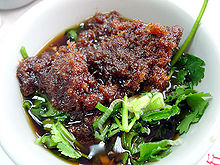 | |
| Place of origin | Chaoshan, China |
|---|---|
| Region or state | Chaoshan, Fujian, Taiwan |
Shacha sauce (Chinese: 沙茶; Pe̍h-ōe-jī: sa-te; also spelled sa cha sauce) is a savory, slightly spicy Chinese condiment used in Min Nan cuisine (primarily Teochew, Fujian, and Taiwanese). It is made from soybean oil, garlic, shallots, chilies, Chinese brill, and dried shrimp. It is also sometimes sold as "Chinese barbeque sauce".
Shacha sauce is used many different ways; as a soup base, a barbeque meat rub, a dipping sauce (for hot pot), or a seasoning for stir-fries. It is also included with instant noodles manufactured in Vietnam, in their own packet alongside packets of soup base, dried vegetables, or other seasonings.
Origin
Shacha sauce is also known as sa-te in the Teochew and Hokkien dialects, reflecting its origin in the satay sauce introduced by expatriate Min Nan people returning to China from Southeast Asia. During the 20th century, Chinese labourers from the Chaoshan region who worked in Southeast Asian countries (e.g., modern-day Malaysia and Indonesia) adapted satay sauce to local tastes, including the introduction of dried seafood. Shacha is now quite different from the peanut-based satay sauce popular in Malaysia and Indonesia. Following the Chinese Civil War, Chaoshan immigrants resettled in Taiwan and introduced shacha sauce to the Taiwanese culinary repertoire. One in particular, Liu Lai-chin, a Tainan-based noodle shop owner originally from Chaoshan, created the iconic Bullhead brand (牛頭牌) of shacha sauce in 1958. In the 1960s and 1970s, as beef consumption slowly gained cultural acceptance in Taiwan, shacha sauce became more popular among locals.
See also
- List of Chinese sauces
- Siu haau sauce
- Peanut sauce
- XO sauce
- Shito - Similar condiment used in Ghana
References
- Mary Kate Tate & Nate Tate (2011). Feeding the Dragon. Kansas City, Missouri, USA: Andrews McMeel Publishing Ltd. p. 270. ISBN 978-1-4494-0111-5. Retrieved 12 April 2012.
- Acciardo, Kelli (2021-07-02). "Chefs Swear By These Under-the-Radar Asian Ingredients for Game-Changing Flavor". Parade: Entertainment, Recipes, Health, Life, Holidays. Retrieved 2021-09-26.
- "How To Shop A Chinese Supermarket Like A Pro". LAist. 2020-01-24. Retrieved 2021-09-26.
- Allen, Gary (2019-02-08). Sauces Reconsidered: Après Escoffier. Rowman & Littlefield. p. 102. ISBN 978-1-5381-1514-5.
- "The secrets behind instant noodle seasoning sachets". VnExpress International. Retrieved 2021-09-26.
- ^ Erway, Cathy (2021-04-14). "There Is No Substitute for Shacha Sauce". TASTE. Retrieved 2022-03-07.
- "Sacha Sauce Goes Out to All My Umami Lovers". Bon Appétit. 5 November 2020. Retrieved 2021-07-04.
- ^ Tseng, Lin-Yi (2018-01-01). "An accidental journey: sha-cha sauce and beef consumption in Tainan since 1949". Social Transformations in Chinese Societies. 14 (2): 107–116. doi:10.1108/STICS-04-2018-0008. ISSN 1871-2673.
| Fujian cuisine | |
|---|---|
| Barbecue sauces | |
|---|---|
This condiment-related article is a stub. You can help Misplaced Pages by expanding it. |
This article related to Chinese cuisine is a stub. You can help Misplaced Pages by expanding it. |
